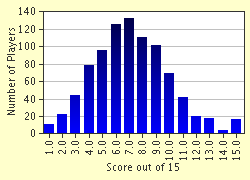Quiz Answer Key and Fun Facts
1. After strenuous cardiovascular exercise, which part of the nervous system is responsible for slowing down heart rate?
2. What does the enzyme 'invertase' digest?
3. You dissolve one gram of iodine, one gram of potassium iodide in 100 ml of distilled water to obtain a certain solution. You dilute this solution and add it to a sample of food. The food turns a blue-black color, confirming the presence of a type of food substance, 'X' in the food.
Name the enzyme that digests 'X' in the mouth.
4. I will describe a system to you, and you must name it.
This system is a part of the blood circulatory system. Because of this system, digested substances are not directly introduced into the bloodstream, but first taken to a certain organ to regulate their levels in order to ensure that the composition of the blood is not disturbed. A certain vein shares its name with this system.
Name the system.
5. Name the artery from which blood is led to a dialysis machine upon the failure of both kidneys.
6. Glycolysis takes place in the cytoplasm of the cell and takes place without the use of oxygen to break down glucose into pyruvic acid.
7. The posterior pituitary gland secretes two hormones. One of these cause the contraction of the uterine muscle during childbirth.
Name the above mentioned hormone.
8. Which part of the kidney does the proximal convoluted tubule lie in?
9. From which fluid do cells draw in oxygen and excrete carbon dioxide into?
10. What is the function of the node of Ranvier?
11. A person dies due to asphyxiation.
What would the probable pH level of such a person's muscular tissue?
12. Which of the following body parts initiates the cardiac cycle?
13. A person suffers from a certain ophthalmic disorder. To correct it, he is required to wear glasses consisting of convex lenses.
What is the biological name of the disorder?
14. A person eats tomatoes, spinach, pulses and cottage cheese in large quantities while consuming little water.
Which of the following diseases is he likely to get?
15. All multicellular organisms respire aerobically.
Source: Author
Rossell
This quiz was reviewed by FunTrivia editor
crisw before going online.
Any errors found in FunTrivia content are routinely corrected through our feedback system.

